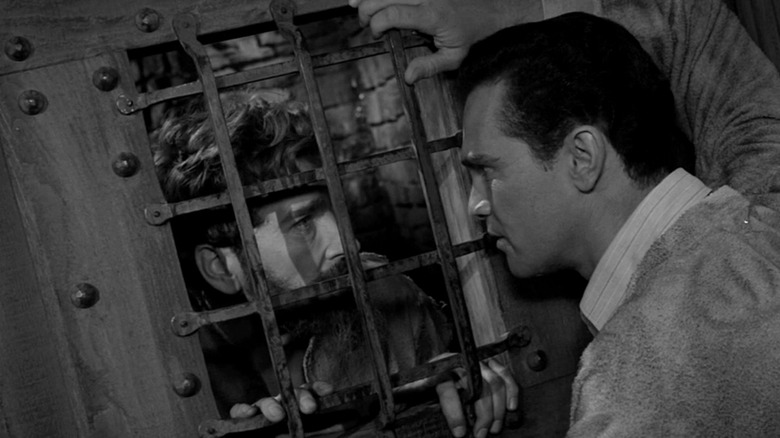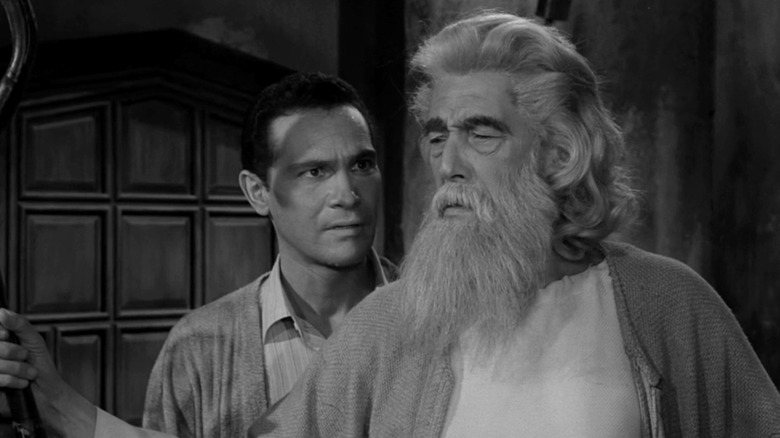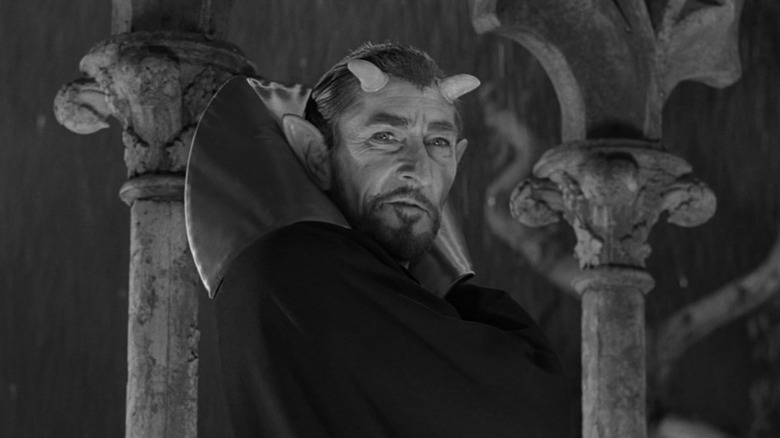How The Twilight Zone's Howling Man Pushed The Limits Of '60s Special Effects
My favorite episode of "The Twilight Zone" is "The Howling Man." Self-adapted from a short story by Charles Beaumont, the episode's star is David Ellington (H.M. Wynant), an American hiker in post-war Europe. Caught in a storm, he stumbles upon a monastery and meets the secretive Order of Truth, led by Brother Jerome (John Carradine). The Order has the titular man (Robin Hughes) imprisoned in a cell, claiming him to be Satan in human form. After some persuasion from both parties, Ellington ultimately frees the prisoner and all of mankind pays for his mistake.
I discovered the episode when I was a Catholic schoolboy and a burgeoning horror fan, so the premise stirred primal fear within my soul. Even now, with my faith lapsed, "The Howling Man" is still an excellent half-hour of TV, with some of the best atmosphere and mystery in "The Twilight Zone."
Many "Twilight Zone" episodes take place in normal American locales, both suburbia and cities, or vague future/sci-fi settings. "The Howling Man," though, unfolds in a Gothic Castle right out of a Universal horror film. Director Douglas Heyes experiments with his framing; the episode has a particular fondness for Dutch angles, but he also keeps the camera moving, drawing the viewer into the story more so than if he stuck with stationary shots.
The biggest technical challenge, though? Portraying the Devil himself. According to "The Twilight Zone Companion" by Marc Scott Zicree, Heyes vetoed Beamount's wish for less is more, believing the audience would feel "cheated" if they didn't see the prisoner become the Devil. The book also details how Heyes and his crew pulled off that transformation.
Lighting the Devil
Thanks to his soft voice and puppy dog eyes, Hughes does a good job playing up the Devil as seemingly innocent. Jerome warns Ellington that "the Devil hath power to assume a pleasing shape," but the Howling Man dispenses with any illusion once he's free. Telekinetically forcing Ellington to the ground, he transforms from a haggard man into the regal Prince of Darkness (sprouting horns and elfen ears) and then disappears in a plume of smoke.
During the first close-up of the Howling Man's transformation, you can notice that his face changes. Part of it is the expression; Hughes trades his earlier sad frown for a smirk. That's not all, though — there's a lighting change disguised by a crack of lightning. As a result, his eyebrows and cheeks sharpen while his skin darkens. His eye pupils also go from brown to silver, creating a sinister contrast with the rest of his face.
What was the lighting change here? The shot used both red and green-filtered lights. Initially, one half was lit and the other was dimmed, but midway through, they swapped that. Since the episode was shot on black-and-white film, the precise color changes were imperceptible.
Cinematographer George T. Clemens discovered this trick while working on the 1931 "Dr. Jekyll and Mr. Hyde" film. He'd even used the effect in an earlier "Twilight Zone" episode, "Long Live Walter Jameson." There, the eponymous lead (Kevin McCarthy) rapidly ages. The wrinkled makeup applied to McCarthy's face was red, so as the lighting slowly changed, it seemed as if the wrinkles were suddenly appearing.
"The Twilight Zone Companion" doesn't specify the makeup used on "The Howling Man," but if I had to guess, they painted Hughes' skin a Satanic red. This would blend in with the red-filtered lights but pop with contrast under the green-filtered ones.
Creating a gradual transformation
However, the rest of the Devil's transformation couldn't be done with only lighting. No, they'd have to use makeup, which couldn't be applied or changed instantaneously. Plus, according to "The Twilight Zone Companion," Heyes was determined to make the transformation as dynamic as possible:
"I had seen many transitions — 'Dr. Jekyll and Mr. Hyde' or 'The Wolf Man' or something — in which they would suddenly become immobile and the makeup would change and then they would start moving. 'I don't want to do that,' I said. 'I want to see him moving all the time the makeup is changing.'"
The crew accomplished this with some clever blocking and the temporal magic of film editing.
During his transformation, the Devil walks past a series of five stone pillars. When he disappears behind one, he re-emerges looking more demonic. Heyes explained that Hughes did the complete walk down the corridor in every stage of the makeup. The camera, stationed on a dolly, would follow him — Heyes carefully timed this so each dolly shot was the same length as the others. Then in the editing room, a section from each take was spliced together into a whole, with the pillars disguising these cuts. "The illusion was that he never stopped moving and the camera never stopped moving," Heyes said.
The editing implies a gradual transformation that the show didn't have the resources to wholly depict. The jump cuts are noticeable, especially on a modern TV, but not debilitatingly so. "The Howling Man" is proof that limitations can often breed the most creative filmmaking.


